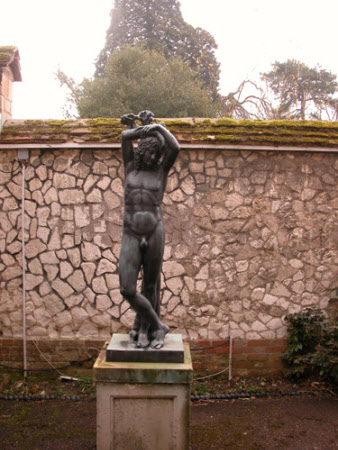The Genius of Eternal Repose
Ferdinand Barbedienne (Calvados 1810 - Paris 1892)
Category
Art / Sculpture
Date
1880 - 1900
Materials
Bronze
Measurements
1500 x 450 x 360 mm
Place of origin
France
Order this imageCollection
Anglesey Abbey, Cambridgeshire
NT 515122
Summary
Bronze, The Genius of Eternal Repose, Ferdinand Barbedienne (Saint-Martin-de-Fresnay, Calvados 1810 - Paris 1892), after the antique, cast Paris, France, 1880-1900. A reduced-size bronze cast of the Narcissus (also known as the Mazarin Hermaphrodite and the Genius of Eternal Rest), a Roman sculpture of the early 3rd century A.D. (A.D. 200-250) in the Musée du Louvre, Paris (MA 435/MR 207). Produced by the foundry of Ferdinand Barbedienne. An effeminate naked youth with long curling hair stands, one leg crossed over another, and his arms held above his head, behind him a tree trunk. On an integral bronze base stamped 'F. BARBEDIENNE. FONDEUR.' and 'REDUCTION MÉCANIQUE/A. COLLAS/BREVETÉ'. Mounted on a stone plinth.
Full description
The antique marble statue, variously called Narcissus, the Mazarin Hermaphrodite, or the Genius of Eternal Rest, was one of the highlights of the collection of antiquities and modern works of art formed by Cardinal Jules Mazarin (1602-1661), chief minister from 1642 until his death, firstly serving King Louis XIII and subsequently his son King Louis XIV. In around 1670, the statue was one of a number in the former Mazarin collection that were mutilated by the duc de Mazarin in a fit of puritanical madness. The statue was one of a number from the Mazarin colllection seized during the French Revolution, entering the Louvre in 1793 (Musée du Louvre, Paris, Inv. MR 207. Jean-Luc Martinez, ed., Les Antiques du Louvre. Une histoire du gout d’Henri IV à Napoléon, Paris 2004, pp. 55-56, fig. 54). It is now recognised to be an eclectic assemblage. The only certainly antique element is the torso, a fragment of an early 3rd century A.D. figure of Narcissus, to which have been added the midriff and legs, as well as the upper part with the head and arms, the latter certainly 17th-century additions. The sculpture reached the height of its fame in the nineteenth century, when it was one of the highlights of the Antiquities galleries in the Louvre. Its popular name of the Genius of Eternal Repose came from a romantic notion in which death was compared with peaceful slumber. This cast was made in the foundry of Ferdinand Barbedienne, who developed the largest bronze-casting business in 19th-century France, which revolutionised the practice of reproducing and publishing vast numbers of bronze sculptures in editions. Barbedienne began his career as an apprentice to a Parisian papermaker and by 1834 he was running a successful business as a wallpaper manufacturer. In 1838, he changed direction, entering into a partnership, called Collas & Barbedienne, with Achille Collas (1795–1859), who had invented a method for making reductions of sculpture and who won a silver medal for his reduction of the Venus de Milo at an exhibition in 1839. The firm, which from 1851 was known simply as Barbedienne, specialised in reproductions of antique and modern sculpture, famous classical antiquities and works by sculptors ranging from Michelangelo to Antoine-Louis Barye. The enterprise expanded rapidly, coming to employ around 300 people and marketing through its printed catalogues some 1,200 subjects. Other specialisms included portrait busts of famous people from history and a wide range of decorative utensils and furniture in various historicising styles. Barbedienne also enjoyed great success at the international exhibitions which were held in London, Paris and other European cities from the Great Exhibition of 1851 onwards. Reductions of the Genius of Eternal Repose were offered in the catalogues of Collas & Barbedienne from 1847 until 1905. The sculpture may be seen in an assortment of casts of ancient sculptures that illustrate a prospectus published before 1850 (Rionnet, Barbedienne, p. 102, fig. 116). It was offered in a range of sizes of reduction, from 2/5 (75 cm) down to the tiny size of 2/20 (10 cm). The Anglesey Abbey reduction is however in fact an unusual 2/3 reduction of the size of the original sculpture (187 cm), so may have been made as a special commission. Small reductions from the Barbedienne foundry of Michelangelo’s Slaves may be seen at Anglesey Abbey, in the Ship Bedroom (NT 515074 & 515075). The Genius of Eternal Repose was formerly mounted upon a modern pedestal bearing an inscription in Latin, commemorating the centenary of the birth of Lord Fairhaven. Jeremy Warren 2019
Provenance
Bequeathed to the National Trust by Huttleston Rogers Broughton, 1st Lord Fairhaven (1896-1966) with the house and the rest of the contents
Credit line
Anglesey Abbey, The Fairhaven Collection (National Trust)
Marks and inscriptions
On the side of bronze base: F. BARBEDIENNE. FONDEUR. On tree trunk: LXI [61] On back of tree trunk, around profile bust of Achille Collas: REDUCTION MÉCANIQUE/A. COLLAS/BREVETÉ
Makers and roles
Ferdinand Barbedienne (Calvados 1810 - Paris 1892), founder
References
Rionnet 2016: Florence Rionnet, Les Bronzes Barbedienne. L’œuvre d’une dynastie de Fondeurs (1834-1954), Paris 2016, p. 213, no. 37. Roper 1964: Lanning Roper, The Gardens of Anglesey Abbey, Cambridgeshire. The Home of Lord Fairhaven, London 1964, p. 62. Christie, Manson & Woods 1971: The National Trust, Anglesey Abbey, Cambridge. Inventory: Furniture, Textiles, Porcelain, Bronzes, Sculpture and Garden Ornaments’, 1971, p. 158.


